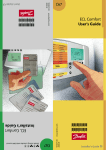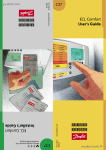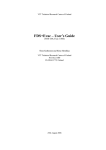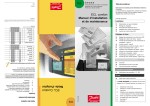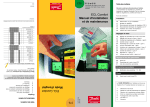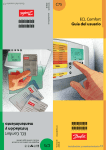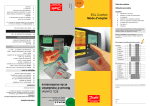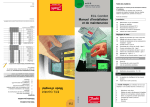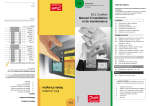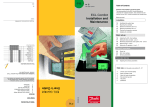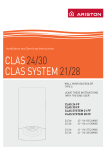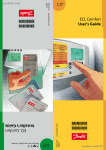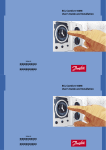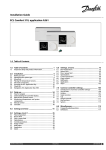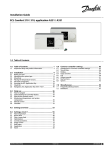Download Danfoss L66 User`s guide
Transcript
VI.JD.T2.02 2006.12 L66 ( ) Mixing and DHW controller www.danfoss.com ECL Comfort Installer's Guide www.danfoss.com *087R8172* *VIJDT202* VI.JD.T2.02 2006.12 Installer's Guide *VIJDT202* *087R8172* ECL Comfort User's Guide L66 User's Guide DHW flow temperature sensor, circuit II S6 DHW return temperature sensor, circuit II P1-1 Circulation pump 1, heating, circuit I P2-1 Circulation pump 2, heating, circuit I P1-2 ECA 73 / 80 / 86, circulation pump 1, DHW, circuit II P2-2 ECA 73 / 80 / 86, circulation pump 2, DHW, circuit II M1 Motorized control valve, circuit I M2 Motorized control valve, circuit II Adjust- Controller ment mode S5 Circuit Shift selector button Return temperature sensor, circuit I Circuit indicator S4 Controller mode Manual operation (used only at maintenance and service) Scheduled operation Flow temperature sensor Constant comfort temperature S3 Constant setback temperature Outdoor temperature sensor Standby mode Arrow buttons. Switch between the lines of the ECL Card. Shift button. Switches between temperatures, changeover points etc. S1 ECL Comfort 301 List of components: If the system you are about to install differs from the shown diagram of a standard heating system, feel free to sketch an outline for comparison. Adaptation of systems, see section 10. Adjust temperatures and values etc. Circuit selector for switching between the circuits. Display indications, controlled units, L66 1 ON A 1 2 2 B ON C D 3 ON E Blank = OFF E: R3 = Opens D: M2 Blank = OFF C: P2-1 = Opens B: M1 Blank = OFF A: P1-1 ON = ON = Closes ON = ON The shown diagram is a fundamental and simplified example and does not contain all components that are necessary in a system. = Closes ON = ON Safety Note To avoid injury of persons and damages to the device, it is absolutely necessary to read and observe these instructions carefully. Necessary assembly, start-up, and maintenance work must be performed by qualified and authorized personnel only. This guide is associated with ECL Card 087B4875 Installer: By: Date: Table of Contents Sections in the Installer’s Guide The documentation for the ECL Comfort controller is composed of numbered sections. Only sections relevant to your ECL Comfort controller are included here. Before you start Installation 10 11 12 14 15 Identifying the system type Mounting the ECL Comfort controller Electrical connections 230 V a.c. Connecting and placing the temperature sensors Inserting the ECL Card Basic Set-up 16 17 18 19 20 21 22 23 26 Adjusting the ECL Card settings Setting the time and date - line A Monitoring temperatures and system units - line B Manual control - line B Setting the heat curve - line C Heating cut-out - line 1 Flow temperature limits - line 2 Room temperature influence - line 3 Control parameters - lines 4-7 Control & Overviews 29 30 31 Check list ECL Card settings Service parameters Extended Service 32 Adjusting the service parameters Miscellaneous 34 Copying with the ECL Card User's Guide (turn the guide over for sections 1-7) 1 2 3 4 5 6 7 Choose your favorite display Select circuit mode Set your room and DHW temperature Set your personal schedule Advantages of the ECL Card Hot points Definitions Before you start Sketch your application The ECL Comfort controller series is designed for a wide range of heating, domestic hot-water (DHW) and cooling systems with different configurations and capacities. If your system differs from the diagrams shown in section 10, you may want to make a sketch of the system about to be installed. This makes it easier to use the Installer’s Guide, which will guide you step-by-step from installation to final adjustments before the end-user takes over. The controller is pre-programmed with factory settings that are shown in the relevant sections of this guide. However, you might come across some settings that are not listed in this instruction. These settings could be related either to recent updates or the use of optional modules (which are described in the instructions in question). How to use this guide This guide is divided into two parts: • User’s Guide: Yellow sections 1-7 • Installer's Guide: Grey sections 10 and onwards The application L66 is very flexible. These are the basic principles: Both circuits can control two pumps. Heating: Typically, the flow temperature is adjusted according to your requirements. The flow temperature sensor (S3) is the most important sensor. The desired flow temperature at S3 is calculated in the ECL controller, based on the outdoor temperature (S1). The lower the outdoor temperature, the higher the desired flow temperature. The motorized control valve (M1) is opened gradually when the flow temperature is lower than the desired flow temperature and vice versa. The return temperature (S4) to the district heating supply should not be too high. If so, the desired flow temperature can be adjusted (typically to a lower value), thus resulting in a gradual closing of the motorized control valve. In boiler-based heating supply the return temperature should not be too low (same adjustment procedure as above). If the measured room temperature does not equal the desired room temperature, the desired flow temperature can be adjusted. Circulation pumps are ON when the desired flow temperature is higher than 20 °C or the outdoor temperature is lower than 2 °C. VI.JD.T2.02 Card L66 2006.12 DHW: If the measured DHW temperature (S5) is lower than the desired DHW temperature, the motorized control valve (M2) is opened gradually and vice versa. If the desired DHW temperature cannot be reached, the heating circuit can be closed gradually. The ECL Comfort controller is a universal controller that can be used for various systems. Based on the shown standard systems, it is possible to configure additional systems. In this section you find the most frequently used systems. If your system is not quite as shown below, find the diagram which has the best resemblance with your system and make your own combinations. The functions can only be realized with ECL Comfort 301 and as of controller version 2.00. 10.1 10b Identifying the system type Indirectly connected heating system and DHW circuit System diagrams in this instruction are principal drawings and do not contain all components which are necessary in your systems. 10.2 Directly connected heating system and indirectly connected DHW circuit Installation Installation 10a Mounting the ECL Comfort controller For easy access, you should mount the ECL Comfort controller near the system. Select one of the three following methods: • Mounting on a wall • Mounting on a DIN rail • Mounting in a panel Screws and rawlplugs are not supplied. Mounting on a wall Socket for mounting on wall: Order code No. 087B1149. Mount the terminal box on a wall with a smooth surface. Establish the electrical connections and position the controller in the box. Secure the controller with the fixing screw. Mounting on a DIN rail Mounting kit: Order code No. 087B1145. A mounting kit is necessary to mount the box with the controller on a DIN rail. Mounting in a panel Connector set: Order code No. 087B1148. The panel plate thickness must not exceed 3 mm. Prepare a cut-out with the dimensions 93 x 139 mm. Pull off the right side of the lid by means of a screwdriver. Insert the controller into the panel cut-out and fix it with the two locks which are placed diagonally in two corners of the controller. 11b Installation Installation 11a 12a 12b Electrical connections 230 V a.c. - in general Terminal Description 1 L 2 N 3 M1 4 M1 5 6 M2 7 M2 8 9 P1-1 230 V a.c. connections - with safety thermostat 10 11 P2-1 12 13 R3 14 25 P1-2 26 28 P2-2 This circuit diagram is only valid if Danfoss actuators are used The relays are to be connected as in the drawing without safety thermostat. 29 Supply voltage 230 V a.c. Supply voltage 230 V a.c. Actuator - open, circuit I Actuator - close, circuit I alt. thermo actuator 230 V a.c. supply voltage for M1, circuit I Actuator - open, circuit II Actuator - close, circuit II 230 V a.c. supply voltage for M2, circuit II Circulation pump I for heating, circuit I 230 V a.c. supply for pump relay R1 Circulation pump II for heating, circuit I 230 V a.c. supply for pump relay R2 Alarm relay 230 V a.c. supply for alarm relay R3 Circulation pump I for DHW, circuit II 230 V a.c. supply for pump relay R4 Circulation pump II for DHW, circuit II 230 V a.c. supply for pump relay R5 Max. load 0.2 A / 230 V a.c. 0.2 A / 230 V a.c. 0.2 A / 230 V a.c. 0.2 A / 230 V a.c. 4 (2) A / 230 V a.c. 4 (2) A / 230 V a.c. 4 (2) A / 230 V a.c. 4 (2) A / 230 V a.c. 4 (2) A / 230 V a.c. Wire cross section: 0.75 - 1.5 mm2 Electrical connections Max. 2 x 1.5 mm2 wires can be inserted into each screw terminal. Incorrect connection can damage the TRIAC outputs. Max. load (terminals 3, 4, (6 and 7)) 0.2 A / 230 V a.c.! Installation Installation 230 V a.c. connections - without safety thermostat 14a 14b Connecting and placing the temperature sensors It is important that the sensors are mounted in the correct position in your system. The temperature sensor mentioned below are sensors used for the ECL Comfort 200 and 300 series which not all will be needed for your application! Outdoor temperature sensor (ESMT) The outdoor sensor should be mounted on that side of the building where it is less likely to be exposed to direct sunshine. It should not be placed close to doors, windows or air outlets. Flow temperature sensor (ESMU, ESM-11 or ESMC) Terminal Description 15 and 16 17 and 16 S1 18 and 16 S2 19 and 16 S3 20 and 16 S4 21 and 16 S5 22 and 16 S6 Type (recomm.) System device bus*, connections for room panel** / remote control** / (relay module) Outdoor temperature sensor Ralarm Flow temperature sensor, circuit I Return temperature sensor, circuit I DHW flow temperature sensor, circuit II DHW return temperature sensor, circuit II Place the sensor max. 15 cm from the mixing point. In systems with heat exchanger, Danfoss recommends that the ESMU-type to be inserted into the exchanger flow outlet. ECA 60 / 62 ECA 61 / 63 ESMT ESM-11 / ESMC / ESMU ESM-11 / ESMC / ESMU ESM-11 / ESMC / ESMU ESM-11 / ESMC / ESMU * The system device bus / room panel / remote control is only active when the outdoor temperature sensor is connected. ** Either room panel or remote control Make sure that the surface of the pipe is clean and even where the sensor is mounted. Return temperature sensor (ESMU, ESM-11 or ESMC) The return sensor should always be placed in / on a pipe with return water flow. Room temperature sensor (ESM-10, ECA 60 / 62 room panel or ECA 61 / 63 remote control) Place the room sensor in the room where the temperature is to be controlled. Do not place it on outside walls or close to radiators, windows or doors. Establish the jumper from 16 to common terminal. Wire cross section for sensor connections: Min. 0.4 mm2 Total cable length: Max. 125 m (all sensors incl. system device bus) Cable lengths of more than 125 m may cause noise sensibility (EMC). DHW temperature sensor (ESMU or ESMB-12) Place the DHW temperature sensor according to the manufacturer’s specification. Terminals 16 and 18 External circuit for alarm contact: R x and Ry are external alarm relay contacts, i.e. pressure controlled switches.. The contacts should be gold-plated. The resistance in the contacts must be lower than 10 ohm (operating conditions 5 V and 1.7 mA). -> Alarm input circuit I Boiler temperature sensor (ESMU, ESM-11 or ESMC) Place the sensor according to the boiler manufacturer’s specification. Flow / air duct temperature sensor (ESM-11, ESMB-12, ESMC or ESMU types) Place the sensor so that it measures a representative temperature. Slab temperature sensor (ESMB-12) Terminal 16 Terminal 18 Place the sensor in the slab. -> Alarm input circuit II Valid for ESM-11: Do not move the sensor after it has been fastened in order to avoid damage to the sensor element. Installation Installation Connecting the temperature sensors and the bus 14c Installation Installation Connecting the room panel / remote control The ECA 60 / 61 / 62 / 63 is activated by the setting in line 10 (section 32). The ECA 60 / 61 / 62 / 63 is powered by the system device bus which means that the bus must be active. The bus is activated by setting the controller address to 15 (section 32, line 199). Override For an active override, you have to choose the mode “scheduled operation”! Input S1 ... S6 (ECL Card C14 only uses S5) can be used for override purposes (section 32, line 141). Connection example without ECA 9010 If the override switch has goldplated contacts, you can choose one of the following solutions or a combination of both: (C14 = 21 only) (C14 = 21 only) Closed switch: Comfort temperature Closed switch: Setback temperature Open switch: Scheduled operation Open switch: Scheduled operation Connection example with ECA 9010 The ECA 9010 module is powered by the system device bus, which means that the bus must be active. The bus is activated by setting the controller address to 15 (line 199). To avoid influence from contact resistance, the use of ECA 9010 is recommended. Red Red Green S1 ... S6 (C14 = S5 only) Brown Brown Comfort Comfort Setback Setback 15a 15b Inserting the ECL Card Installation The ECL Card contains factory settings for a standard system. If the actual system differs from the standard system, the controller must be adjusted accordingly. After the adjustment, the new settings should be stored on the ECL Card. For ECL Card copying and daily use including adjustment of temperatures and schedules, insert the ECL Card with the yellow side facing you. For system set-up adjustments, the grey side of the ECL Card - the installer’s side - must be facing you. How to insert your ECL Card the first time After the power has been switched on, open the lid on the front side of the controller. Place the ECL Card with the yellow side facing you. This enables the controller to read the ECL Card data. The controller immediately starts to copy the application type and factory settings from the ECL Card. After copying, the display will show you the application type. After approx. 10 sec. the display will change to display line C. As a main rule, the ECL Card should always remain in the controller during service, maintenance and setting. If the card is removed or left in the controller with the grey side facing you, please note that: • After approx. 25 min.: - The controller cannot be operated. - The controller reverts to display C (section 1). • The ECL Card must not be exposed to direct heat or sunshine. Display example: CPY 0 Software version, ECL Card Line Circuit Time Outdoor temp. C99 Application type C37 05 109 Software version, controller If several controllers are installed in the system you can write a title on the ECL Card with a permanent ink pen. Desired room temp. Do not remove the ECL Card while copying. The data on the ECL Card can be damaged! C 1835 3 0 3 20 6 9 12 15 18 21 24 The controller is now ready to be set to control your system. When you store your personal settings on your ECL Card, the factory settings will be overridden. If the display keeps showing CPY, see section 34b. Installation Understanding the ECL Card 16 Adjusting the ECL Card settings 17 Setting the time and date line A General principles Actual time When the controller is connected and operating you can check and adjust all or some of the basic settings. Turn the ECL Card so that the grey side is facing you (see the example below). A 1035 Year 107 0222 Month, day Use the arrow buttons to move from line to line of the ECL Card, for example line 2: 1 ON 2 2 ON Use the shift button to switch between minutes, hours, years, months and days. 3 ON Set the correct time and date. 2 Setting to be adjusted 40 90 In case of a power break, which lasts longer than 12 hours, the time and the date have to be set again. All other settings are stored as programmed. Value in range indicator Use the plus / minus buttons to adjust the settings. Use the yellow side of the card to change the schedules. See User’s Guide, section 4. In some displays more than one setting or value can be adjusted. Use the shift button to switch between the options. The circuit selector shifts between circuit I and II. You can adjust all settings and service parameters individually. Update of the ECL Card after maintenance and service All new settings can be stored on the ECL Card. For details about copying, see section 34. The grey side of the ECL Card The grey side of the ECL Card Basic set-up Basic set-up Circuit Line 1 18 Monitoring temperatures and system units - line B Controlled units 1 B 1 2 2 ON ON Shift to manual mode. 3 ON Controlled units 1 B Flow temp. (S3) 65 30 ON 65 If the sensor is short-circuited, the display will indicate it as “- - -“. Basic set-up Controller mode 30 OFF or ON when The motorized actuator (gear motor) closes or opens the controlled unit as long as the relevant button is pushed. If pushed for more than 3 seconds, the actuator continues to close or open the valve. The thermo actuator activates the valve as long as the button is pushed. If pushed for more than 3 seconds, the actuator continues to open the valve. If you are in doubt, remove the controller and check the ohmic value between the relevant terminals. Relationship between temperature and ohmic value Ω The grey side of the ECL Card 3 Check the activation direction of the actuator either by looking at it or by feeling whether the temperature of the actual pipe changes as expected. This operation applies to both circuits, if available. 1600 1500 During manual operation, all control functions are deactivated. 1400 1300 1200 1100 1000 900 800 -50 -25 0 25 50 75 100 125 150 °C The grey side of the ECL Card Basic set-up If a sensor is not mounted or is disconnected, the display will indicate it as “- -”. 805 845 883 922 961 1000 1039 1078 1117 1155 1194 1232 1271 1309 1347 1385 1423 1462 1501 1539 1578 2 Controlled units are switched the relevant button is pushed. The activity of the motorized control valve is shown as arrows below the valve symbol. When the circulation pump is operating, it is indicated as ON below the pump symbol. -50 -40 -30 -20 -10 0 10 20 30 40 50 60 70 80 90 100 110 120 130 140 150 2 ON Choose the unit you want to control. The selected unit symbol will blink. This display can also show the actual and desired flow and return temperatures for circuit II. Ω 1 Return temp. (S4) Push and hold the shift button to see: - the calculated flow temperature - the desired return temperature limitation. °C 19 Manual control line B 20a 20b Setting the heat curve line C 1 ON C 1 2 2 3 Parallel displacement ON ON 15 Slope 0 Displacement Setting range Factory setting I -9 ... 9 K 0K If you want to adjust the parallel displacement of the heat curve, push the shift button. The symbol for the parallel displacement will blink. Slope Circuit Setting range Factory setting I 0.2 ... 3.4 1.5 Make your adjustments. The symbol for the slope of the heat curve will blink. Adjust the slope of the heat curve, if required. Basic set-up Basic set-up Circuit oC 1.8 2.2 2.6 3.0 3.4 110 1.4 100 90 80 1.0 70 60 0.6 50 40 0.2 30 20 oC 10 -30 -20 -10 0 10 20 How to determine another heat curve, if necessary: Choose the calculated flow temperature for your system and the determined min. outdoor temperature for your area. Pick the heat curve closest to the crossing point of these two values. The setting of the desired room temperature has an influence on the calculated flow temperature (heat curve), no matter if a room temperature sensor is connected or not. Floor heating systems This controller is factory set for radiator systems, which typically are high flow temperature systems. To control floor heating systems, which typically are low flow temperature systems, you need to change the heat curve according to your type of system. Slope Circuit Setting range Typical setting I / (II) 0.2 ... 3.4 1.0 / (1.0) Whether it is reasonable to change the slope or parallel displacement will depend on the individual heat requirement. Small increases or reductions in the heating temperature can be implemented by means of the parallel displacement. The grey side of the ECL Card The grey side of the ECL Card 21 Heating cut-out line 1 1 ON 1 1 1 2 2 1 ON ON 18 Setting range Factory setting I 10 ... 30 °C 18 °C Set the outdoor temperature limit at which you want the heating system to stop. 2 3 ON 40 90 Max. flow temp. The valve closes and after about 3 min. the heating circulation pump stops. The min. limitation set in line 2 will be ignored. 2 Flow temperature limits, min. and max. Circuit Setting range Factory setting I 10 ... 150 °C min. 10 , max. 90 °C The mentioned setting range and factory settings may vary from the settings on your ECL Card. The left end of the setting range blinks. Adjust the min. limit of your system temperature. Choose the max. limit. The right end of the setting range blinks. Accumulated outdoor temp. 18 °C Adjust the max. limit. Heating Heating OFF Heating Time This function can save energy by stopping the heating system when the outdoor temperature gets above a set limit. The heating system switches ON again when the outdoor temperature and the accumulated outdoor temperature become lower than the set limit. The heating cut-out is only active when the controller mode is scheduled operation. When the limit value is set to 30, there is no heating cut-out. The grey side of the ECL Card The grey side of the ECL Card Basic set-up Basic set-up 2 ON Setting range Circuit Actual outdoor temp. 1 2 Min. flow temp. Limit for heating cut-out Temp. 22 Flow temperature limits line 2 23a 23b Room temperature influence line 3 B: Reference room temperature control This section is only relevant if you have installed a room temperature sensor or ECA 60 / ECA 61 / ECA 62 / ECA 63. 1 ON 1 2 3 ON ON Set a positive value for the min. influence and a negative value for the max. influence. Influence 3 Min. influence Used if your system is not equipped with thermostats and you select the room with room temperature sensor as a temperature reference for the rest of the rooms. 0 -40 Max. influence Min. limitation Desired room temperature Room temperature influence Circuit Setting range Factory setting I 0 ... 99 / -99 ... 0 min. 0, max. -40 The bar below the min. value blinks. Adjust the min. influence. Select the max. influence. The bar below the max. value blinks. Adjust the max. influence. There are two basic principles for control of the room temperature influence: A: Max. room temperature limitation Use this limitation if your system is fully equipped with thermostats and you also want to obtain a max. limitation of the room temperature. The controller will allow for free heat gains, i.e. solar radiation or heat from a fire place, etc. Influence Desired room temperature Room temperature Max. limitation Room temperature Basic set-up Basic set-up 3 Max. limitation The room temperature sensor in the reference room registers the difference between the desired and the actual room temperature. The desired flow temperature will be corrected to eliminate this difference. Example 1 The actual room temperature is 2 degrees too low. The influence at max. limitation (right corner of the display) is set to -35. The influence at min. limitation (left corner of the display) is set to 20. Heat curve H is 1.8. Result: The desired flow temperature is changed by 2 x 20 x 1.8 x 0.1 = 7.2 degrees. Example 2 The actual room temperature is 2 degrees too high. The influence at max. limitation (right corner of the display) is set to -35. The influence at min. limitation (left corner of the display) is set to 20. Heat curve H is 1.8. Result: The desired flow temperature is changed by 2 x (-35) x 1.8 x 0.1 = -12.6 degrees. The max. influence determines how much the room temperature should influence the desired flow temperature. Example The actual room temperature is 2 degrees too high. The influence at max. limitation (right corner of the display) is set to -40. The influence at min. limitation (left corner of the display) is set to 0. Heat curve H is 1.8. Result: The desired flow temperature is changed by 2 x -40 x 1.8 x 0.1 = -14.4 degrees. The grey side of the ECL Card The grey side of the ECL Card 26a 4 26b Control parameters lines 4-7 Proportional band, Xp 7 Neutral zone, Nz Circuit Setting range Factory setting Circuit Setting range Factory setting I / II 1 ... 250 K 80 / 80 K I / II 0 ... 9 K 3/3K Set the proportional band. A higher value will result in a stable but slow control of the flow temperature. Integration time constant, Tn Circuit Setting range Factory setting I / II 5 ... 999 sec. 30 / 20 sec. Set a high integration time constant to obtain a slow but stable reaction to deviations. A small integration constant will make the controller react fast but with less stability 6 Running time of the motorized control valve Circuit Setting range Factory setting I / II 5 ... 250 sec. 35 / 15 sec. Set the running time of the motorized control valve according to the example. This is the time it takes the controlled unit to move from fully closed to fully open position. How to calculate the running time of a motorized control valve The running time of the motorized control valve is calculated using the following methods: The neutral zone is symmetrical around the desired flow temperature value, i.e. half the value is above and half the value is below this temperature. Control parameters (lines 4-7) are overruled if thermo actuator is chosen (OFF). If you want to tune the PI regulation precisely, you can use the following method: • Set the integration time (line 5) to its max. value (999 sec.). • Decrease the value for the proportional band (line 4) until the system starts hunting with a constant amplitude (it might be necessary to force the system by setting an extreme value). • Find the critical time period on the temperature recording or use a stop watch. Temp. Seated valves Running time = Example: Valve stroke (mm) x actuator speed (sec. / mm) 5.0 mm x 15 sec. / mm = 75 sec. Rotating valves Running time = Example: Turning degrees x actuator speed (sec. / degr.) 90 degrees x 2 = 180 sec. Critical time period Time This time period will be characteristic for the system, and you can evaluate the settings from this critical period. Integration time = Proportional band = 0.85 x critical time period 2.2 x proportional band value in the critical time period. If the regulation seems to be too slow, you can decrease the proportional band value by 10%. Make sure there is a consumption when you set the parameters. The grey side of the ECL Card The grey side of the ECL Card Basic set-up Basic set-up 5 Set the neutral zone to a high value if you can accept a high variation in flow temperature. When the actual flow temperature is within the neutral zone, the controller does not activate the motorized valve. 29a Check list ✓ Is the ECL Comfort controller ready for use? Make sure that the correct power supply is connected to terminals 1 (Live) and 2 (Neutral). See section 12 or 13. Check that the required actuators, pumps, fans, dampers and burners are connected to the correct terminals. See sections 12 or 13. Check that all sensors are connected to the correct terminals. See section 14. Mount the controller and switch on the power. Insert the ECL Card with the yellow side facing you and push , if necessary. See section 15. ✓ 29b Adapting the ECL Comfort controller to the system Turn the ECL Card so that the grey side faces you and push , if necessary. Set the time and the date (line A). See section 17. Check that all settings in the controller (sections 30 and 31) are set or that the factory settings comply with your requirements. If your system differs from the diagram shown on the cover, you should check and alter your service parameters, if necessary. Check that the system settings mentioned in section 10 have been set correctly. Choose manual operation as controller mode. See section 2. Having completed the manual operation check, choose scheduled operation as controller mode. Check that the temperatures shown in display A and B match the actual sensors. See section 1. Control & overviews Control & overviews Check that valves open and close, and that required pumps, fans, dampers and burners start and stop when operated manually. See section 19. 30a ECL Card settings (circuit I) A Time and date Section 17 B System information Sections 18 & 19 C Heat curve Setting ranges 30b ECL Card settings (circuit II) Factory settings A Time and date Section 17 B System information Section 20 C Your settings Setting ranges Sections 18 & 19 Factory settings Your settings Slope 0.2 ... 3.4 1.5 See section 20 Parallel displacement -9 ... 9 K 0K See section 20 1 1 Limit for heating cut-out 10 ... 30 °C 18 °C See section 21 2 Flow temperature, min. / max. limits 10 ... 150 °C Control & overviews Control & overviews 2 min. 10, max. 90 °C See section 22 3 3 Room temperature influence 0 ... 99 / -99 ... 0 min. 0, max. -40 See section 23 4 4 Proportional band, Xp 1 ... 250 K Proportional band, Xp 80 K 1 ... 250 K See section 26 See section 26 5 5 Integration time constant, Tn 5 ... 999 sec. 80 K Integration time constant, Tn 30 sec. 5 ... 999 sec. 20 sec. See section 26 See section 26 6 6 Running time of the motorized control valve 5 ... 250 sec. 35 sec. Running time of the motorized control valve 5 ... 250 sec. 15 sec. See section 26 See section 26 7 7 Neutral zone, Nz Neutral zone, Nz 0 ... 9 K See section 26 3K 0 ... 9 K See section 26 3K 31a Service parameters (10-199) Circuit I (heating and cooling) Lines Setting ranges Factory settings Circuit I (heating and cooling) Lines Setting ranges Factory settings 141 Override input selection OFF / 1 ... 6 11 Setback temperature dependent on outdoor temperature OFF / -29 ... 10 °C -15 °C 142 Restart period, TR OFF / 1 ... 99 min. °C 12 Boost 0 ... 99% 0% % 0 min. min. 14 Optimizing time constant OFF / 10 ... 59 15 Adaptive function of room temperature OFF / 1 ... 30 OFF OFF 21 Total stop ON / OFF OFF 22 Pump exercise ON / OFF OFF 23 Valve exercise ON / OFF OFF 24 Gear motor / thermo actuator ON / OFF 31 Return temperature limitation - upper limit (X-axis) -60 ... 20 °C 32 Return temperature limitation - upper limit (Y-axis) 10 ... 110 °C 33 Return temperature limitation - lower limit (X-axis) -60 ... 20 °C 34 Return temperature limitation - lower limit (Y-axis) 10 ... 110 °C 35 Return temperature influence - max. limitation -9.9 ... 0 ... 9.9 36 Return temperature influence - min. limitation -9.9 ... 0 ... 9.9 40 °C -15 °C 60 °C 81 Time constant of input for sensor S1 1 ... 250 50 sec. 5 sec. OFF 197 LON reset ON / OFF ON 198 Daylight saving time changeover ON / OFF ON 15 Factory settings 50 °C °C 35 Return temperature influence - max. limitation -9.9 ... 0 ... 9.9 -2.0 °C 36 Return temperature influence - min. limitation -9.9 ... 0 ... 9.9 0.0 °C 37 Time constant for return temperature limitation OFF / 1 ... 50 25 141 Override input selection OFF / 1 ... 6 142 Restart period, TR OFF / 1 ... 99 min. 145 Changeover time, TP 0.0 ... 23.9 146 Pressure stabilization time, TST 1 ... 99 sec. 153 Changeover delay, TCH OFF / 1 ... 99 sec. K Your settings OFF °C 0.0 OFF 15 30 Return temperature limitation 10 ... 110 °C 37 Time constant for return temperature limitation OFF / 1 ... 50 25 52 Closed valve / normal operation ON / OFF 153 Changeover delay, TCH OFF / 1 ... 99 sec. 22 Pump exercise ON / OFF -2.0 43 Parallel operation of DHW and heating circuits OFF / 1 ... 99 K OFF 146 Pressure stabilization time, TST 1 ... 99 sec. Circuit II (DHW) Lines Setting ranges min. 16.1 199 Master / slave address 0 ... 9, 15 ON 15 °C 20 min. 145 Changeover time, TP 0.0 ... 23.9 °C OFF 20 min. min. 16.1 15 sec. 5 sec. Control & overviews 20 Optimization based on room / outdoor temperature ON / OFF K Your settings OFF 196 Service pin LON ON / OFF OFF 17 Influence on desired flow temperature OFF / 1 ... 20 K OFF Control & overviews Your settings 10 Choice of room panel / remote control 1, 2 1 13 Reference ramping 0 ... 99 min. 31b Service parameters (10-199) 32 Adjusting the service parameters In addition to the settings in line 1 to 7 on the grey side of the ECL Card, there is an extended service menu from line 10 and onwards. Push repeatedly to reach the lines numbered 10 and onwards. 0 Value 10 Line Range indicator Now you can move to any line of your choice. 32a Service parameter(s) 10-11 10 Choice of room panel / remote control Circuit Setting range Factory setting I 1 ... 2 1 Decides the communication with the room panel or remote control. Please note that the room panel / remote control is only active if the system device bus is active. The bus is active when the outdoor temperature sensor is connected. Choose between 1: Room panel ECA 60 / 62 or remote control ECA 61 / 63 with address A 2: Room panel ECA 60 / 62 or remote control ECA 61 / 63 with address B The room panel / remote control has no influence on the DHW control. Set the parameter value. You can select any of the two circuits no matter what line you are in. You will not necessarily enter the same line number. See the service parameters in section 31. Check that you have entered all the required settings in circuit I - and circuit II, if available. If you want to copy the new settings to the ECL Card (recommended by Danfoss), see section 34. Make a note of your new settings in the parameter list in section 31. I OFF / -29 ... 10 °C -15 °C Below this outdoor temperature, the setback temperature setting has no influence. -29 ... 10: The setback temperature depends on the outdoor temperature, when the outdoor temperature is above the set limit. The lower the outdoor temperature, the less the temperature reduction. When the outdoor temperature is below the set limit, there is no temperature reduction. OFF: The setback temperature does not depend on the outdoor temperature. Reduction 100% 0% -29 -20 -10 Setting line 11 The grey side of the ECL Card 0 10 20 Outdoor temperature °C The grey side of the ECL Card Extended service Extended service When you have entered all your personal settings, turn the ECL Card over so that the yellow side faces you. 11 Setback temperature dependent on outdoor temperature Circuit Setting range Factory setting 32b Service parameter(s) 12-13 12 Boost Circuit 32c Service parameter(s) 14-15 14 Optimizing time constant Setting range Factory setting I 0 ... 99% 0% Shortens the heating-up period by increasing the desired flow temperature by the percentage you set. Set the percentage at which you want the desired flow temperature increased temporarily. Circuit Setting range Factory setting I OFF / 10 ... 59 OFF Optimizes the start and stop times for the comfort temperature period to obtain the best comfort at the lowest energy consumption. The lower the outdoor temperature, the earlier the heating cut-in. Adjust the optimizing time constant. The value consists of a two digit number. In order to shorten the heating-up period after a setback temperature period, the desired flow temperature can be increased temporarily (max. 1 hour). At optimizing the boost is active in the optimization period (line 14). The two digits have the following meaning: Digit 1 If a room temperature sensor or an ECA 60 / 61 / 62 / 63 is connected, the boost stops when the room temperature has been reached. 1 Heat accumulation of the building light 2 medium System type Radiator systems 3 heavy 4 medium 5 heavy Digit 2 Dimensioning temperature Capacity 0 - 50 °C large 1 • - 45 °C • • • 5 • - 25 °C normal • • 9 - 5 °C small The boost also stops at the end of an optimizing period. Floor heating systems 13 Reference ramping Circuit Setting range Factory setting I 0 ... 99 min. 0 min. The time in which the desired flow temperature increases slowly to avoid load peaks in the heat supply. Set the ramping time for the controller. Temperature °C OFF: No optimization. The heating starts and stops at the times set in the schedule. Time (min.) In order to avoid load peaks in the supply network, the flow temperature can be set to increase slowly after a period with setback temperature. This causes the valve to open slowly. 15 Adaptive function of room temperature Circuit Setting range Factory setting I OFF / 1 ... 30 OFF Controls how fast the room temperature adapts to the desired room temperature. The adaptive funtion will eliminate the difference between the desired and the actual room temperature. This is done by integrating the difference and adjusting the desired flow temperature. OFF: The adaptive funtion is cancelled. The grey side of the ECL Card 1: The desired temperature is adapted quickly. 30: The desired temperature is adapted slowly. The grey side of the ECL Card Extended service Extended service Setting line 13 Dimensioning temperature: The lowest outdoor temperature (usually determined by your system designer in connection with the design of the heating system) at which the heating system can maintain the designed room temperature. 32d Service parameter(s) 17-20 17 Influence on desired flow temperature (Tflow.ref(I)) Circuit Setting range 21 Total stop Factory setting I OFF / 1 ... 20 K OFF The desired flow temperature in heating circuit I can be influenced by an external reference. OFF: The desired flow temperature in circuit I is not influenced by any other controller (slave). Circuit Setting range Factory setting I ON / OFF Decide whether you want a total stop during the setback temperature period. ON: 1 ... 20: The desired flow temperature is increased by the set value (line 17), if the demand of a slave is higher. Temp. 32e Service parameter(s) 21 OFF The desired flow temperature is lowered to 10 °C. The min. setting of the flow temperature (line 2, section 22) is overruled. Desired flow temp. (°C) Setting line 17 Tflow.ref(I) 10 °C Tflow.ref(II) Time Time Example: If a slave controller demands a higher temperature than that of the master controller (Tflow.ref(I)), the temperature of the master will be increased accordingly (Tflow.ref(II)) + the setting (line 17). OFF: No total stop Desired flow temp. (°C) The function of line 17 can compensate for heat losses between master and slave controlled systems. Time I ON / OFF OFF The optimized start and stop time can be based on either room or outdoor temperature. ON: Optimization based on room temperature, if measured. OFF: Optimization based on outdoor temperature. Use this setting if the room temperature is not measured. The grey side of the ECL Card The grey side of the ECL Card Extended service Extended service 10 °C 20 Optimization based on room / outdoor temperature Circuit Setting range Factory setting 32f Service parameter(s) 22-24 22 Pump exercise Circuit 30 Return temperature limitation Setting range Factory setting I / II ON / OFF OFF / OFF Exercises the pump to avoid blocking in periods without heat demand. ON: Setting range II 10 ... 110 °C 50 °C Set the return temperature you accept for the heating / DHW circuit. Set the acceptable return temperature limit. For some applications the return temperature limitation for heating circuits is set in lines 31-34 (outdoor temperature dependent limitation). The valve receives a signal to open and close every third day around noon. OFF: The valve exercise is not active. 31-34 24 Gear motor / thermo actuator Circuit Setting range Factory setting I ON / OFF ON Choose the actuator type for your valve. Gear motor OFF: Thermo actuator (ABV type) Return temperature limitation The return temperature limitation is based on the outdoor temperature. Typically in district heating systems a higher return temperature is accepted at a decrease in outdoor temperature. The relationship between the return temperature limits and outdoor temperature is set in two coordinates. The upper limit coordinate is set in lines 31 and 32 and the lower limit coordinate in lines 33 and 34. Treturn 80 Control parameters (lines 4-7) are overruled if thermo actuator is chosen (OFF). Lower limit Line 34 60 Upper limit Line 32 40 20 Tout -15 Line 33 The grey side of the ECL Card 0 +15 Line 31 The grey side of the ECL Card Extended service Extended service Factory setting Factory setting I ON / OFF OFF Exercises the valve to avoid blocking in periods without heat demand. ON: Setting range When the return temperature falls below or gets higher than the set value, the controller automatically changes the desired flow temperature to obtain an acceptable return temperature. The influence is set in lines 35 and 36. 23 Valve exercise ON: Circuit The pump is switched ON for 1 minute every third day around noon. OFF: The pump exercise is not active. Circuit 32g Service parameter(s) 30-34 32h Service parameter(s) 31-34 31 Return temperature limitation - upper limit (X-axis) Circuit Setting range Factory setting I -60 ... 20 °C 15 °C Set the outdoor temperature value (see drawing). 35 Return temperature influence - max. limitation Circuit Influence higher than 0: The desired flow temperature is increased, when the return temperature gets higher than the set limit. Factory setting I 10 ... 110 °C 40 °C Set the return temperature limitation referring to the outdoor temperature value set in line 31 (see drawing). Set the return temperature (Y coordinate) for the upper limit. (The corresponding X coordinate is set in line 31). Influence lower than 0: The desired flow temperature is decreased, when the return temperature gets higher than the set limit. Influence Max. limitation > 0 33 Return temperature limitation - lower limit (X-axis) Circuit Setting range Factory setting I -60 ... 20 °C -15 °C Set the outdoor temperature value (see drawing). 34 Return temperature limitation - lower limit (Y-axis) Circuit Setting range Factory setting I 10 ... 110 °C 60 °C Set the return temperature limitation (see drawing). Return limit Return temp. Set the return temperature (Y coordinate) for the lower limit. (The corresponding X coordinate is set in line 33). Example The return limit is active from 50 °C. The influence is set to -2.0. The actual return temperature is 2 degrees too high. Result: The desired flow temperature is changed by -2.0 x 2 = -4 degrees. Normally, the setting in line 35 is lower than 0 in district heating systems to avoid a too high return temperature. Typically, the setting in line 35 is 0 in boiler systems because a higher return temperature is acceptable (see also line 36). The grey side of the ECL Card Extended service Extended service 0 Max. limitation < 0 Set the outdoor temperature value (X coordinate) for the lower limit. (The corresponding Y coordinate is set in line 34). The grey side of the ECL Card Factory setting Set the influence of the max. return temperature limitation (set in line 30 or lines 31-34). 32 Return temperature limitation - upper limit (Y-axis) Setting range Setting range I / II -9.9 ... 0 ... 9.9 -2.0 / -2.0 Set the influence from the return temperature on the desired flow temperature. Set the outdoor temperature value (X coordinate) for the upper limit. (The corresponding Y coordinate is set in line 32). Circuit 32i Service parameter(s) 35 32j Service parameter(s) 36 Service parameter(s) 37 36 Return temperature influence - min. limitation Circuit Setting range Factory setting I / II -9.9 ... 0 ... 9.9 0.0 / 0.0 Set the influence from the return temperature on the desired flow temperature. Set the influence of the min. return temperature limitation (set in line 30 or lines 31-34). Influence higher than 0: The desired flow temperature is increased, when the return temperature gets below the set limit. Influence lower than 0: The desired flow temperature is decreased, when the return temperature gets below the set limit. Influence Min. limitation > 0 0 Return limit 32k 37 Time constant for return temperature limitation Circuit Setting range Factory setting I / II OFF / 1 ... 50 25 / 25 Controls how fast the actual return temperature adapts to the desired return temperature limitation. Adjust the time constant for the return limitation. The setting will eliminate the difference between the acceptable and the actual return temperature. The difference is integrated to adjust the desired flow temperature. OFF: The desired flow temperature will not be adjusted any further. 1: The desired flow temperature will be adjusted quickly. 50: The desired flow temperature will be adjusted slowly. Return temp. Min. limitation < 0 Example The return limit is active up to 50 °C. The influence is set to -3.0. The actual return temperature is 2 degrees too low. Result: The desired flow temperature is changed by -3.0 x 2 = -6 degrees. Extended service Extended service Normally, the setting in line 36 is 0 in district heating systems because a lower return temperature is acceptable. Typically, the setting in line 36 is higher than 0 in boiler systems to avoid a too low return temperature (see also line 35). The grey side of the ECL Card The grey side of the ECL Card 32l Service parameter(s) 43 43 Parallel operation of DHW and heating circuits Circuit Setting range Factory setting I OFF / 1 ... 99 K OFF Choose whether the heating circuit is to operate in dependence of the DHW circuit. 52 Closed valve / normal operation Circuit Setting range Factory setting I ON / OFF OFF The heating circuit can be closed when the controller acts as slave and when DHW charging is active in the master. OFF: Independent parallel operation, i.e. the DHW and the heating circuits operate independently of each other. It makes no difference whether the desired DHW temperature can be reached. 1 ... 99: Dependent parallel operation, i.e. the desired heating temperature depends on the DHW demand. Choose how much the DHW temperature (circuit II) can drop before the desired heating temperature (circuit I) has to be decreased. 32m Service parameter(s) 52 ON: The valve in the heating circuit is closed* during active DHW charging in the master controller. OFF: The flow temperature control remains unchanged during active DHW charging in the master controller. *) The desired flow temperature is set to 10 °C. The setting in line 52 must be considered if this controller is a slave. Temp. Line 43 (acceptable deviation) Desired DHW temp. Actual DHW temp. Setting range Parallel operation with decreased heating temp. Factory setting I 1 ... 250 Set the time constant for the sensor S1 input. A low setting is equivalent to a fast sampling time and a high setting is equivalent to a slow sampling time. Setting Time constant 1 ~ 180 sec. 10 ~ 220 sec. 20 ~ 261 sec. 100 ~ 568 sec. 200 ~ 917 sec. 250 ~ 1092 sec. If the actual DHW temperature deviates more than the set value (line 43), the gear motor M1 in the heating circuit will close to such an extent that the DHW temperature stabilizes at the lowest acceptable value. The grey side of the ECL Card The grey side of the ECL Card 50 Extended service Extended service Circuit 1 ... 250: Time 100% parallel operation 81 Time constant of input for sensor S1 32n Service parameter(s) 141 141 Override input selection Circuit Setting range 32o Service parameter(s) 142-153 142 Restart period, TR Factory setting I / II OFF / 1 ... 6 OFF / OFF Choose an unused temperature sensor input for overriding the schedule for circuit I and / or circuit II. The override can be activated for comfort or setback mode. For override the controller's mode must be in 'scheduled operation'! Circuit Setting range Factory setting I / II OFF / 1 ... 99 min. 20 / 20 min. When the controller receives an alarm, the pump stops and an alarm is shown in the alarm display (the display is blinking, see section 1c). The restart period is the time which should elapse before the pump in question is allowed to start again. OFF: No restart period. OFF: The controller's schedule is not overridden. 1 ... 99: The pump will start again after the restart period has elapsed. 1 ... 6: Select an unused sensor input S1 ... S6 for the override of the circuit in question. Connection example 145-153 Pump control , overview If the override switch has gold-plated contacts, you can choose one of the following solutions: Pressure Limit ON Closed switch: Comfort temperature Closed switch: Setback temperature PI OFF ON PII OFF TP TP TCH Changeover switch: Setback or comfort temperature Connection example with ECA 9010 TST TCH TST Pump I Pump II Changeover time (line 145) Changeover delay (line 153) Pressure stabilization time (line 146) Pressure Limit Extended service Extended service (used if the override switch does not have gold-plated contacts). PI: PII: TP: TCH: TST: ON PI 16 - Brown OFF Green (S1 ... S6) 15 - Red ON PII OFF Alarm TP TCH TST TCH TST The ECA 9010 module is powered by the system device bus, which means that the bus must be active. The bus is activated by setting the controller address to 15 (line 199). The grey side of the ECL Card The grey side of the ECL Card 32p Service parameter(s) 145-153 Setting range Factory setting I / II 0.0 ... 23.9 16.1 / 16.1 The changeover time determines the moment when the activated pump stops and the deactivated pump starts. Circuit Setting range 197 LON reset Example: 16.1 the change will take place at 16:00 hours each day 20.3 the change will take place at 20:00 hours every third day 0.2 the change will take place at midnight every second day 8.0 the change will take place at 08:00 hours every tenth day. 198 Daylight saving time changeover Circuit Setting range 146 Pressure stabilization time, TST Setting range Factory setting Factory setting I ON / OFF ON This setting is only used in connection with LON communication (see the documentation for the used communication unit). Circuit Setting range Factory setting I ON / OFF ON Choose whether you want the change to summer / winter time to be automatic or manual. ON: The changeover time is automatically deactivated if one pump has an alarm or if only one pump exists in the heating system. Factory setting I ON / OFF OFF This setting is only used in connection with LON communication (see the documentation for the used communication unit). Please note this special setting range. The figures to the left of the decimal point represent the time in hours and the figure to the right of the decimal point represents the frequency in days. Circuit 32q 196 Service pin - LON 145 Changeover time, TP Circuit Service parameter(s) 196-198 The controller’s built-in clock automatically changes + / - one hour on the standardized days for daylight saving time changeover for Central Europe. OFF: You change manually between summer and winter time by setting the clock backward or forward. I / II 1 ... 99 sec. 15 / 15 sec. The pressure stabilization time starts when a pump switches ON. The pressure stabilization time has to elapse before the controller can read the pressure control switch. Extended service Extended service Choose the pressure stabilization time. When the chosen pressure stabilization time is too short, the active pump will stop immediately after the pressure stabilization time has elapsed. 153 Changeover delay, TCH Circuit Setting range Factory setting I / II OFF / 1 ... 99 sec. 5 / 5 sec. The changeover delay is the time from the first pump stops until the next pump starts. OFF: No changeover delay. One pump application. 1 ... 99: A pump will start when the changeover delay has elapsed. The changeover delay has to be chosen in systems with two pumps. The grey side of the ECL Card The grey side of the ECL Card 32r Service parameter(s) 199 199 Master / slave address Circuit Setting range Factory setting I 0 ... 9, 15 15 The setting is relevant when more controllers are working in the same ECL Comfort system (connected via the system device bus (ECL Comfort BUS)). 0: The slave receives information about the outdoor temperature (S1), system time, and signal for DHW demand in the master. 1 ... 9: The slave receives information about the outdoor temperature (S1), system time, and signal for DHW demand in the master. The slave sends information about the desired flow temperature to the master. 15: The controller is master. The master sends information about the outdoor temperature (S1), system time, and the DHW demand signal. The master receives the desired flow temperature information from the slaves with addresses 1 ... 9. The bus is active and connected ECAs are powered. The ECL Comfort controllers can be connected via the bus to perform a larger system. The controller, which is physically connected with the outdoor temperature sensor, is the master of the entire system and automatically gets the address 15. However, more slaves can have the address 0 if they only have to receive information about outdoor temperature, system time, and signal for DHW demand in the master. The grey side of the ECL Card Extended service Extended service Each slave must be configured with its own address (1 ... 9). The grey side of the ECL Card 34a 34b Copying with the ECL Card Check the ECL Card and the software generations (see following example). Copy personal settings to additional controller(s) in identical systems Insert the ECL Card with the yellow side facing you. Ensure that the other controller(s) use(s) the same ECL Card type. (If this is not the case, please read section 15). Go to line 8 (is not displayed), which is the first line below line 7. Insert the ECL Card, which contains the personal settings, with the yellow side facing you. Application type C37 Software version, ECL Card 05 109 Go to line 9 (is not displayed), which is the second line below line 7. Select the copying direction (from the card to the controller). Software version, controller CPY Store new controller settings on the ECL Card All new settings* can be stored on the ECL Card. Insert the ECL Card with the yellow side facing you. Card Go to line 9 (is not displayed), which is the second line below line 7. 0 C99 Controller Copying direction Copy. CPY 0 Card Store new ECL Card application in the controller C99 Controller Copying direction If you insert an ECL Card with another application type, it is necessary to copy it to your controller. Insert the ECL Card with the yellow side facing you. The controller will keep showing CPY. Accept to copy settings from controller to ECL Card. CPY When the copying is finished, the controller returns to display line C. * Time and date settings are not stored on the ECL Card. Card 0 C99 Controller Copying direction Do not remove the ECL Card while copying. The data on the ECL Card can be damaged! Do not remove the ECL Card while copying. The data on the ECL Card can be damaged! Miscellaneous Miscellaneous If you have copied your personal settings to the ECL Card, you cannot restore the factory settings! Copy. The yellow side of the ECL Card The yellow side of the ECL Card 7a 7b Definitions Air duct temperature Humidity, relative Temperature measured in the air duct where the temperature is to be controlled. This value (stated in %) refers to the indoor moisture content compared to the max. moisture content. The relative humidity is measured by the ECA 62 / 63 and is used for the calculation of the dew point temperature. Balance temperature This setpoint is the basis for the flow / air duct temperature. The balance temperature can be adjusted by the room temperature, the compensation temperature and the return temperature. The balance temperature is only active if a room temperature sensor is connected. Comfort operation Normal temperature in the system controlled by the schedule. During heating the flow temperature in the system is higher to maintain the desired room temperature. During cooling the flow temperature in the system is lower to maintain the desired room temperature. Limitation temperature Temperature that influences the desired flow / balance temperature. Pt 1000 sensor All sensors used with the ECL Comfort controller are based on the Pt 1000 type. The resistance is 1000 ohm at 0 °C and it changes with 3.9 ohm / degree. Optimization Temperature maintained in the circuits during comfort periods. Normally during daytime. The controller optimizes the start time of the scheduled temperature periods. Based on the outdoor temperature, the controller automatically calculates when to start in order to reach the comfort temperature at the set time. The lower the outdoor temperature, the earlier the start time. Compensation temperature Return temperature A measured temperature influencing the flow temperature reference / balance temperature. The temperature measured in the return influences the desired flow temperature. Controller mode indicator Room temperature sensor Black arrow to the right of the symbols indicating the present mode. Temperature sensor placed in the room (reference room, typically the living room) where the temperature is to be controlled. Comfort temperature Desired room temperature Temperature which is set as the desired room temperature. The temperature can only be controlled by the ECL Comfort controller if a room temperature sensor is installed. If a sensor is not installed, the set desired room temperature however still influences the flow temperature. In both cases the room temperature in each room is typically controlled by radiator thermostats / valves. Room temperature Temperature measured by the room temperature sensor, room panel or remote control. The room temperature can only be controlled directly if a sensor is installed. The room temperature influences the desired flow temperature. Schedule Temperature based on a setting or a controller calculation. Schedule for periods with comfort and setback temperatures. The schedule can be made individually for each week day and may consist of up to 3 comfort periods per day. Dew point temperature Setback temperature Temperature at which the humidity in the air condensates. Temperature maintained in the heating / DHW circuit during setback temperature periods. Desired temperature Factory settings Settings stored on the ECL Card to simplify the set up of your controller the first time. State / mode indicators Temperature measured in the flow at any time. White arrow to the left of the symbols (sun / moon). The white arrow indicates the present state, comfort (sun) or setback (moon), when the controller is in scheduled operation mode. The black arrow symbol indicates the mode of the controller. Flow temperature reference Time line / bar Flow temperature Temperature calculated by the controller on basis of the outdoor temperature and influences from the room and / or return temperatures. This temperature is used as a reference for the control. Heating circuit The circuit for heating the room / building. Line with numbers representing the hours. Below the time line, time bars represent scheduled periods with comfort temperature. The bar is divided into half hour sections. Weather compensation Flow temperature control based on the outdoor temperature. The control is related to a user-defined heat curve. Heat curve A curve showing the relationship between actual outdoor temperature and required flow temperature. DHW circuit The circuit for heating the domestic hot water (DHW). The definitions apply to the Comfort 200 as well as ECL Comfort 300 series. Consequently, you might come across expressions that are not mentioned in your guide. 6a 6b Hot points The time shown in the display is one hour off? See the summer time changeover in line 198, section 32. The time shown in the display is not correct? The internal clock may have been reset, if there has been a power break for more than 12 hours. Set time and date. See section 17. The ECL Card is lost? Switch the power off and on again to see the system type and the software generation of the controller. Order a replacement from your Danfoss representative. Insert the new ECL Card with the yellow side facing you and make sure that you copy your personal settings from the controller to the ECL Card. See section 34. How to make an extra comfort period in the schedule? You can make an additional comfort period by pushing the shift and + buttons simultaneously for 2 seconds. See section 4. How to remove a comfort period in the schedule? You can remove a comfort period by pushing the shift and - buttons simultaneously for 2 seconds. See section 4. How to restore your personal settings? Insert the ECL Card with the yellow side facing you. Go to line 9 (is not displayed), which is the second line below line 7. Select copy direction 'card to controller' (left to right) by using the shift button. Push the + button to copy. See section 5. The room temperature is too low? Make sure that the radiator thermostat does not limit the room temperature. If you still cannot obtain the desired room temperature by adjusting the radiator thermostats, the flow temperature is too low. Increase the desired room temperature (section 3). If this does not help, adjust the heat curve / balance temperature (section 20). The room temperature is too high during setback periods? Make sure that the min. flow temperature limitation is not too high. See section 22. The temperature is unstable? Check that the flow temperature sensor is correctly connected and in the right place. Adjust the control parameters (section 26). If the controller has a room temperature signal, see section 23. The controller does not operate and the control valve is closed? Check that the flow temperature sensor is measuring the correct value, see section 1. Check the influence from other measured temperatures. This is a collection of frequently asked questions for the ECL Comfort 200 as well as ECL Comfort 300 series. Consequently, you might come across some questions that do not apply to your application. 5a 5b Advantages of the ECL Card Save your personal settings to the ECL Card Go to line 9 (is not displayed), which is the second line below line 7. CPY 0 Card C99 Controller Restore ECL Card data After establishing your favorite temperatures, comfort periods etc., and after copying these to the ECL Card, you can set alternative settings. Insert the ECL Card and make the temporary settings, e.g. for holidays, but do not copy these. To restore your favorite settings, copy these from the ECL Card to the controller. Insert the ECL Card. Go to line 9 (is not displayed), which is the second line below line 7. Copying direction Accept to copy personal settings from the controller to the ECL Card. The controller will return to display line C when the copying is completed. This takes approx. 15 seconds. By saving your personal settings* to the ECL Card, you have ensured that your settings will not be lost if the controller settings are changed by mistake. * Time and date settings are not stored on the ECL Card. Prevent unauthorized operation One of the primary advantages of the controller is the setting security. If you remove the ECL Card, and the ECL Comfort controller is not operated during the next 25 minutes (approx.): - the controller returns to display line C (section 1) - further changes are not possible - the controller continues its operation CPY Card 0 C99 Controller Copying direction Choose to copy the ECL Card to the controller (from left to right). Copy Do not remove the ECL Card while copying. The data on the ECL Card can be damaged! When the ECL Card is inserted with the yellow side facing you, the controller can be operated again. Do not remove the ECL Card while copying. The data on the ECL Card can be damaged! If you have copied your personal settings to the ECL Card, you cannot restore the factory settings! The yellow side of the ECL Card The yellow side of the ECL Card 4a 4b Set your personal schedule Monitor the current schedules Add an extra comfort period Select between lines 1-7 (Monday, Tuesday ...... Sunday) to see your individual schedules. Push the shift and + button simultaneously for 2 seconds. Changeover time Line Circuit Time line Periods with comfort temp. are shown as black bars Change the schedules Select appropriate day. The new period appears Adjust the new period. Remove a comfort period Select the period to be removed (blinking changeover point) Push shift and - buttons simultaneously for 2 seconds. Cancel changes in your personal settings The changeover point blinks Push - and + buttons simultaneously for 2 seconds to restore the factory settings of the actual schedule. Adjust the first blinking changeover point, if required. The end of the bar moves, extending or reducing the comfort period. Shift to next changeover point and adjust accordingly. Change the schedule for circuit II Select circuit II to view or change the schedule. Use the same method for changes as for circuit I. The yellow side of the ECL Card The yellow side of the ECL Card 2 Select circuit mode During scheduled operation (clock), the state indicator (a white arrow) will show you the control mode of the selected circuit. The white arrow will blink when this is a heating circuit and it is in the optimizing period. The mode can be set differently for each circuit by means of the function selector. However, if manual operation (hand) is chosen, this mode will apply to all circuits. Go to display C. Circuit I: Setting the desired room temperature Function selector (black arrow) State indicator (white arrow) 20 20 Function selector. Push the button to change the mode of the circuit. The black arrow shows you which of the modes you have chosen. What do the symbols mean? Manual operation Used only at maintenance and service. Note! The protection against frost is switched off when this mode is selected. Scheduled operation This is the normal mode. The temperature is controlled according to your schedule with automatic changeover to / from comfort and setback temperature periods. Constant comfort temperature The schedule is not in operation. Use this mode when a constant comfort temperature is desired. Constant setback temperature The schedule is not in operation. Use this mode when you are away on holiday, etc. Standby The heating circuit is stopped. The system is still protected against frost. In the DHW circuit, however, the DHW temperature is controlled according to the setback temperature. 3 Set your room and DHW temperature Desired room temp. in comfort mode 16 Desired room temp. in setback mode Select the constant comfort mode. Set the desired room temperature for the comfort mode. Select the constant setback mode. Set the desired room temperature for the setback mode. Select the desired mode (section 2). The setting of the desired room temperature is important even if a room temperature sensor / room panel / remote control is not connected. Is the room temperature too low? Make sure that the radiator thermostat does not limit the room temperature. If you still cannot obtain the desired room temperature by adjusting the radiator thermostats, the flow temperature is too low. Increase the desired room temperature. Circuit II: Setting the desired DHW temperature 55 Desired DHW temp. in comfort mode 10 Desired DHW temp. in setback mode Select the constant comfort mode. Set the desired DHW temperature for the comfort mode. Select the constant setback mode. Set the desired DHW temperature for the setback mode. Select the desired mode (section 2). The yellow side of the ECL Card The yellow side of the ECL Card 1a Choose your favorite display (circuit I) Choose the display - A, B, or C - for daily operations. Room temperature - display A Choose the display - A, B, or C - for daily operations. DHW temperature - display A Room temp. Line DHW temp. (S5) A Line Circuit 20 Outdoor temp. (S1) 1b Choose your favorite display (circuit II) A 56 Circuit 3 19 55 Desired room temp. Desired DHW temp. System information - display B The display will show the room temperature if a room panel or a remote control is installed. If not, two bars will be shown. State of controlled units 1 1 Line System information - display B 1 Line B 2 2 2 2 3 ON Circuit State of controlled units 1 B 56 DHW temp. 3 30 Return temp. 55 Desired DHW temp. ON Circuit 65 Flow temp. 30 Return temp. Push and hold the shift button to see: - the calculated flow temperature - the desired return temperature limitation. Today’s schedule - display C Time Line Circuit C 1835 0 Today's schedule - display C 3 6 9 12 15 18 21 24 Today's schedule Time Line Circuit C Outdoor temp. 1835 3 0 3 20 6 9 12 15 18 21 24 Desired room temp. Today's schedule The controller automatically reverts to display C if the card has been reinserted or the power supply has been interrupted. The controller automatically reverts to display C if the card has been reinserted or the power supply has been interrupted. If the temperature value is displayed as "- -", the sensor in question is not connected. "- - -" means that the sensor is shortcircuited. Is the display blinking? See section 1c. If the temperature value is displayed as "- -", the sensor in question is not connected. "- - -" means that the sensor is shortcircuited. The yellow side of the ECL Card The yellow side of the ECL Card 1c Choose your favorite display (alarm) Choose the alarm settings by pushing the button until there is no circuit indication (display / lights). The ECL Comfort controller is designed by Danfoss for the automatic temperature control of heating, domestic hotwater (DHW), ventilation and cooling systems. Choose the display - A, B, or C - for daily operations. Some of the advantages of the ECL Comfort controller system are: • Secure control and the optimum use of energy resources. • Control of system temperatures according to seasonal changes and variations in outdoor temperatures. • Setback temperature periods and low energy consumption while you are out or asleep save heating costs. Alarm - display A Line A Alarm status: ON = active alarm OFF = inactive alarm on Alarm info, circuit I 2 -- Alarm info, circuit II When an alarm is active, the display will blink. Press any button and the blinking will stop. The display will then revert to normal. The following alarms are possible: -no pump alarm 1 one pump alarm 2 two pump alarms Press the minus button to cancel / remove the alarm. B -- Alarm input (sensor S2) The following alarms are possible: -no pump alarm 78 pump alarm from circuit I via relay R x (1300 Ω) 0 pump alarm from circuit II via relay Ry (1000 Ω) - - - two pump alarms, both circuits have a pump alarm The yellow side of the ECL Card Operating the ECL Comfort controller in general When operating the controller it is advisable to keep the lid open in order to view the entire display. During operation the ECL Card must be inserted with the yellow side facing you. The ECL Card, which is equipped with a memory chip, is simple and easy to handle. The ECL Card is divided vertically into two columns each representing a circuit. Horizontally the ECL Card is divided into lines that represent the different control and programming options for the two circuits. Each line is shown in the display of the controller, which gives you an instant overview of the operation, settings etc. How to use the ECL Comfort User's Guide Alarm - display B Line Save energy - save money - improve your comfort temperature This guide provides you with an easy instruction for the ECL Comfort controller. The Installer's Guide, the grey section (turn the guide over), contains the complete list of factory settings and various detailed adjustments that ensure an efficient and continuous operation of your system. Table of Contents Daily use Section 1 Choose your favorite display 2 Select circuit mode 3 Set your room and DHW temperature 4 Set your personal schedule 5 Advantages of the ECL Card 6 Hot points 7 Definitions The documentation for the ECL Comfort controller is composed of numbered sections. Only sections that are relevant to your ECL Comfort controller are included here. Installer's Guide: Grey sections 10 and onwards. Turn the guide over. Your personal schedule: 6-8 Heating 0 3 6 16-22 9 12 15 18 21 24 1 Monday 2 Tuesday 3 Wednesday 4 Thursday 5 Friday 6 Saturday 7 Sunday 8-23 5-8 DHW 0 3 6 18-22 9 12 15 18 21 24 1 Monday 2 Tuesday 3 Wednesday 4 Thursday 5 Friday 6 Saturday 7 Sunday 8-23 Factory settings are grey. The functions can only be realized with ECL Comfort 301 and as of controller version 2.00.






































